The National Park Service was storing three buckets full of highly radioactive uranium in the visitor area of its Grand Canyon museum for nearly two decades, according to the park safety manager.
The 5-gallon buckets were located near the taxidermy exhibit, and one was so full of uranium ore that it couldn’t be sealed, according to Elston “Swede” Stephenson, a manager who sent a rogue email to all Park Service employees earlier this month, AZ Central reports.
Tour groups, often including children, sometimes spent 30 minutes or more near the taxidermy exhibit for demonstrations. Using standards set by the US Nuclear Regulatory Commission, Stephenson calculated that children could have been exposed to doses of radiation above federal safety standards within three seconds. Adults could have been exposed to dangerous doses in under 30 seconds.
For unknown reasons, the three buckets full of uranium were moved from a basement in Grand Canyon park headquarters to the Grand Canyon museum when it opened in 2000, according to Stephenson. The buckets were discovered by accident in March 2018 when the hobbyist teenage son of a park employee brought a Geiger counter into the taxidermy-collection room.
Workers moved the buckets to another part of the museum after the discovery, but they remained on site until June 18, 2018, a few days after Stephenson was made aware of the buckets and reported them to Park Service officials. Technicians wearing dishwashing gloves used a mop handle to move them into a truck and drive them offsite, he told AZ Central.
According to Stephenson, the ore was dumped into Orphan Mine, a disused uranium mine two miles from Grand Canyon Village, a cluster of hotels and shops where many visitors to the park pass through. But for unknown reasons, the empty buckets were brought back to the museum. They were then rediscovered inside the museum in November 2018, according to AZ Central, when they set off geiger counters brought by US Occupational Safety and Health Administration (OSHA) inspectors who arrived to follow up on a report filed by Stephenson.
The Grand Canyon is home to several disused uranium mines like Orphan Mine. A 20-year mining ban in the park went into effect in 2012. The mining industry recently attempted to sue the government to overturn the ban, but in October 2018 the Supreme Court declined to hear the case. Despite that decision, the National Mining Association said it would continue to lobby the Trump administration to overturn the ban.
According to the Park Service, a joint investigation is underway involving the OSHA and Arizona’s health department, AZ Central reports.




